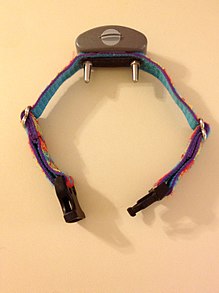
Back Collar elèctric Catalan Telereizgerät German Collar eléctrico Spanish Collier électrique French קולר נגד נביחות HE Collare elettrico Italian Электрошоковый ошейник Russian Antiskällhalsband Swedish


A shock collar or remote training collar, also known as an e-collar, Ecollar, or electronic collar, is a type of training collar that delivers shocks to the neck of a dog[3] to change behavior. These collars incorporate a radio-controlled electronic device and are worn around the dog's neck. Many European and South American countries view shock collars as animal cruelty and have banned their use.[4][2][5][6][7][8][9][10][11][12][13][14][15][excessive citations] The mechanism behind shock collars involve inflicting varying levels and duration of pain, which generates fear[16][17][18][19] and serves as a deterrent for undesirable behaviors.[20] Some models of shock collar models offer additional features such as a tone or vibrational setting that can be used as an alternative or in combination with the shock. Certain advanced collars include Internet mapping capabilities and GPS functionality to track the dog's location or notify the owner about its whereabouts.
In the late 1960s, shock collars were initially developed for training hunting dogs, but they were originally designed with only one high level of power. Many modern versions are capable of delivering varying levels of shock. In areas where shock collars are legal, they are generally accessible, although Petco took the lead as the first major U.S. retailer to cease their sale.[21][22] Shock collars have been used in a range of applications, including behavioral modification, obedience training, and pet containment, as well as military, police and service training. Although similar systems exist for other animals, shock collars designed for domestic dogs are the most commonly used.
- ^ https://sfstandard.com/community/san-francisco-first-city-ban-dog-shock-collars-static-correction/# "San Francisco May Be First City in the Nation to Ban Shock Collars". San Francisco Standard. January 16, 2023.
- ^ a b "Germany - Cruelty - German Animal Welfare Act | Animal Legal & Historical Center".
- ^ Wensley, Sean (2 February 2016). "Vets call for ban on electric 'shock collars'". The Veterinary Nurse. 7 (1): 56. doi:10.12968/vetn.2016.7.1.56.
- ^ "Electric Shock Collars". Kennel Club UK.
- ^ "Dog Keeping laws for Germany".
- ^ "Elektronische halsband voor honden vanaf volgend jaar verboden". 4 April 2019.
- ^ "Netherlands to ban shock collars for dogs, limit breeding of 'designer cats'".
- ^ "Achtung vor verbotenen Halsbändern für Hunde" [Beware of prohibited collars for dogs]. Heute.at (in German). 13 September 2021.
- ^ "Fynsk dyrlæge forarget over salg af stødhalsbånd: Hundene ved ikke, hvad der rammer dem". TV2 Fyn (in Danish). Retrieved 2022-04-21.
- ^ "Animal Welfare Decree" (PDF). Ministry of Agriculture and Forestry.
- ^ "FINLEX - Ajantasainen lainsäädäntö: Eläinsuojelulaki 247/1996".
- ^ "Notkun rafmagnsólarinnar tilkynnt sem ill meðferð til MAST". Mannlíf.is (in Icelandic). 2019-01-17. Retrieved 2022-04-21.
- ^ "Rafmagnsólar hunda bannaðar - Vísir". visir.is (in Icelandic). 15 July 2011. Retrieved 2022-04-21.
- ^ Lindin, Ina-Kristin (2017-01-27). "Dømt for bruk av strømhalsbånd". NRK (in Norwegian Bokmål). Retrieved 2022-04-21.
- ^ Gernes, Jonatan (2021-05-20). "Elhalsband gav plågsamma skador på hunden". hallandsposten.se (in Swedish). Retrieved 2022-04-21.
- ^ Seligman, Martin E. (September 1970). "On the generality of the laws of learning". Psychological Review. 77 (5): 406–418. doi:10.1037/h0029790. S2CID 145661354. ProQuest 614281984.
- ^ Mowrer, O. H. (November 1939). "A stimulus-response analysis of anxiety and its role as a reinforcing agent". Psychological Review. 46 (6): 553–565. doi:10.1037/h0054288. ProQuest 614288080.
- ^ Miller, Neal E. (April 1948). "Theory and experiment relating psychoanalytic displacement to stimulus-response generalization". The Journal of Abnormal and Social Psychology. 43 (2): 155–178. doi:10.1037/h0056728. PMID 18861377. ProQuest 614244452.
- ^ Dunsmoor, Joseph E.; Murty, Vishnu P.; Davachi, Lila; Phelps, Elizabeth A. (April 2015). "Emotional learning selectively and retroactively strengthens memories for related events". Nature. 520 (7547): 345–348. Bibcode:2015Natur.520..345D. doi:10.1038/nature14106. PMC 4432479. PMID 25607357.
- ^ Guilherme Fernandes, Joana; Olsson, I. Anna S.; Vieira de Castro, Ana Catarina (November 2017). "Do aversive-based training methods actually compromise dog welfare?: A literature review". Applied Animal Behaviour Science. 196: 1–12. doi:10.1016/j.applanim.2017.07.001. hdl:10216/112687.
- ^ "Petco will stop selling electronic 'shock' collars". CNN. 6 October 2020. Retrieved 2023-06-02.
- ^ "Petco ends sale of electronic shock collars, calls on competitors to also 'Stop the Shock' with online petition". USA TODAY. Retrieved 2023-06-02.